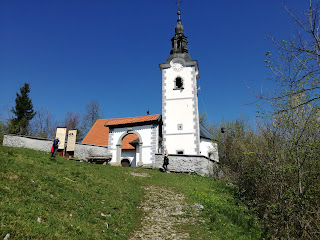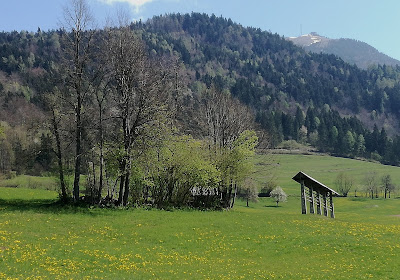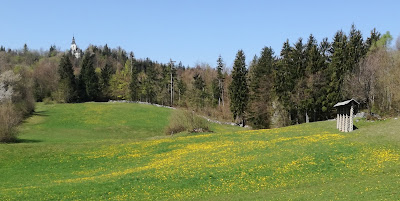About this walk
I’ve not been able to visit Slovenia this year because of Coronavirus restrictions, so I thought I would tell you about a short walk I completed in 2019 with my friend Nicole (on the last day of our holiday to the Vipava valley). There are two great thing about this walk:
Firstly, after just a short, easy climb you will experience fantastic views of plains to the South and the Kamnik-Savinja Alps towards the North.
Secondly, it is it is very close to the Jože Pučnik airport at Brnik, so if you have a late flight (as we did), you can squeeze it in before you fly home.
The trail is called Pod Krošnjami or Under the tree crowns and goes from Church of St Mary of the Annuncition at Adergas to the plateau at Štefanja Gora, where you can visit St Stephens Church and walk amongst attractive alpine meadows towards Zgornja Štefanja Vas. If you have time you can extend the route to Sponja Štefanja Vas. There is also a longer route which starts at Cerklje na Gorenjskem.
The shorter walk (which we did) is around 4.5 miles, takes 2 – 2.5 hours. After an initial short climb, it is level with good paths. The extension is an extra 1.7 miles.Getting to Adergas
The shorter walk (which we did) is around 4.5 miles, takes 2 – 2.5 hours. After an initial short climb, it is level with good paths. The extension is an extra 1.7 miles.
Both routes are available on Viewranger by following the links below:
Adegas to Štefanja Gora Plateau
Sponja Štefanja Vas extension
Getting to Adergas
As the Google map below shows, it is just a 13 minute drive north of the airport, via Šenčur. You drive across the plains towards Češnjevek, then climb steeply into Adergas. There is a large parking area by the Church of St Mary of the Annuncition and Monastery Velesov, both of which dominate this small settlement. There are signs in the parking area showing the walking route.
 |
| Map of route from airport to Aldergas |
 |
| Photo of board by car park showing walking route |
Our route
The walking route is well signposted. We went eastward along the main road and then followed the footpath signs along a residential road on the left, which climbs and becomes a track as it enters a forest by a house.
After a short climb through the forest, we took a track to the left. A little further on we enjoyed some fantastic views of Aldergas and the surrounding plains.
We climbed further up the track until it opened out onto the plateau close to Pri Mežnarju (a hiking hut and restaurant), with views of St Stephens church ahead.
 |
| St Stephen's Church |
After stopping for some photographs, we walked up to the church, then towards Pri Mežnarju, which looked a nice place to for refreshments and a bite to eat:
We then followed the road to Zgornja Štefanja, enjoying the lovely views of the Kamnik-Savinja Alps, with attractive meadows and the traditional Slovenia hay racks in the foreground. Below are some of the pictures I took as I walked:
On reaching the outskirts of the village, we followed a track to the right, then took the second forest path on the right, which went westerly, then turned south westerly and downwards to meet the track where we had turned left earlier. We then retraced our steps to the start of the walk.
Refreshments
The closest place to Aldergas for refreshments is Cerklje na Gorenjsken. However, as we still has time before our flight, we had lunch at the Gostilina Pr’ Bizjak in Zgornja Bela (near Preddvor), as it had good reviews on Trip Advisor. We weren't dissapointed and it was particularly lovely sitting on the terrace enjoying the gardens.
Gostilna Pr' Bizjak: Zgornja Bela 20, 4205 Preddvor www.gostilnabizjak.si (15 minute drive from Adergas)
We also had a flying visit to the Hotel Alma/Grad Hrib at Preddvor for a coffee, as I wanted to show Nicole this favorite spot of mine. I often go there for a drink or ice cream before flying home. The views of the lake and moutains from the Hotel terrace are spectacular.
 |
| Lake and Mountains at Grad Hrib, Preddvor |


























































